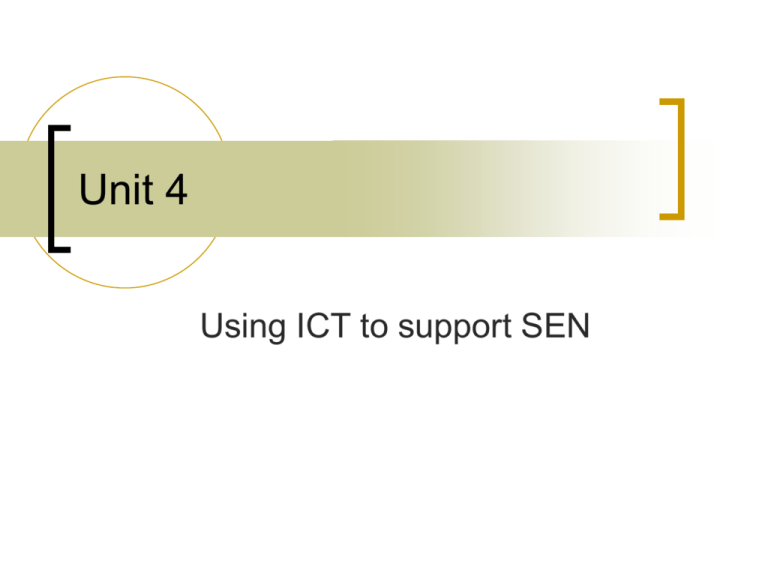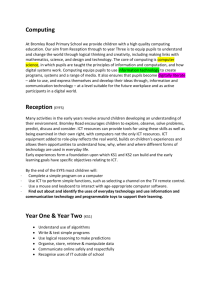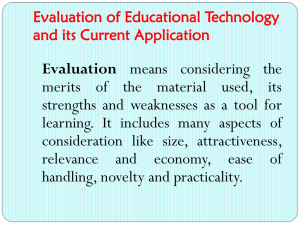Dead links
advertisement

Unit 4 Using ICT to support SEN Special Needs and ICT ICT has been recognised as a valuable tool in the area of SEN for a long time. In addition to the support it provides it can minimise the differences between an SEN child and one without learning difficulties. The approaches to the use of ICT must however be tailored to the individual and be regularly reviewed. Types of SEN Specific Learning Difficulty (SPLD) Moderate Learning Difficulty (MLD) Severe Learning Difficulty (SLD) Profound and Multiple Learning Difficulty (PMLD) Emotional and Behavioural Difficulty (EBD) Speech, Language and Communication Need (SLCN) Hearing Impairment (HI) Visual Impairment (VI) Multi-Sensory Impairment (MSI) Physical Difficulty (PD) Autistic Spectrum Disorder (ASD) Other (OTH) Activity 1: What are the main categories of SEN that impact upon your role? Learning Difficulties: Dyslexia Dyscalculia ASD including Asperger’s Syndrome Hyperlexia Down’s Syndrome Gifted and Talented Physical Impairment: Visually Impaired Hearing Impaired Cerebral Palsy Dyspraxia Epilepsy Emotional Behavioural Difficulties: ADD Attention Deficit Disorder ADHD Attention Deficit Hyperactivity Disorder What types of ICT can help? Adventure games Information handling programs Multimedia Logo Overlay keyboards Speech recognition systems Spellcheckers, glossaries and thesauri Touch screens Word processors, including predictive word processors and those with voice output Integrated Learning Systems Why ICT? Access technology – it liberates the student by allowing physical access to the curriculum that would otherwise be denied the the student A differentiation tool catering for all needs allowing for progression Allows access to a wider audience Stimulates and motivates Allows for high quality materials to be produced Information accessed from the Internet Good record keeping tool Encourages independent work Why ICT? Enables inclusion in classroom activities Pupils are active participants Offers different learning styles Keeps pupils on task Develops independence Allows learning at pupils own pace and is private Can demonstrate pupils potential Can allow for social interaction and access to wider community (Internet) Great presentation tool Teaching and Learning in Special Educational Needs Physical and Sensory disabilities ICT can be used to: Switch access to classroom activities, matching, sorting, word processing. Translate text into speech and speech into text. Prepare work which is specially adapted with large fonts, symbols and particular colours. Teaching and Learning cont… Learning Difficulties Enhance the development of activities which are clear, focused and attractive to pupils. Enable pupils to practise skills in a different context, numerous repetitions in order to aid learning Support language development activities Multi sensory ways Tips Keep things on one page to avoid scrolling Have plenty of white space Include summaries to text Use simple, clear, large fonts (comic sans) Images are very useful to people with cognitive difficulties Use a recording and reporting program like IEP Writer Speech and language difficulties Talking word processors Talking books Word banks Predictive software Drill and skill software, Starspell, Word Shark, phonic CD’s EBD children ICT can help level out feelings of defeat and low esteem. Adventure games and control activities empower the child. MLD children – most common Word processors (talking), spellcheckers, thesauri, predictive word processors Drill and skill software (including Maths) Adventure games Problem solving (including Roamer and Logo) Paint or draw programs to mix text and images SLD children As with the previous slide Touch screens Speech recognition word processors Programs like ‘Clicker’ (overlays) PMLD children As with previous slides but with specialist equipment like switch technology Specialist equipment designed for the individual child, eg software controlled by blowing or speaking into a microphone Dyslexia and ICT Dyslexia is a specific learning difficulty that hinders learning of literacy skills. This problem with managing verbal codes in memory is neurologically based and tends to run in families. Other symbolic systems such as mathematics and musical notation can be affected. Dyslexia type difficulties Many SEN children exhibit these difficulties but are they dyslexic? Auditory discrimination Left and right Maths computation Memory Organisation Pronunciation Reading Sequencing Spelling visual discrimination Children with exceptional abilities Give them research tasks related to the topic studied Present findings to the class Ask the children to describe how they research a topic Push the children to higher limits, eg create multimedia or a website Give challenges of a secondary nature





